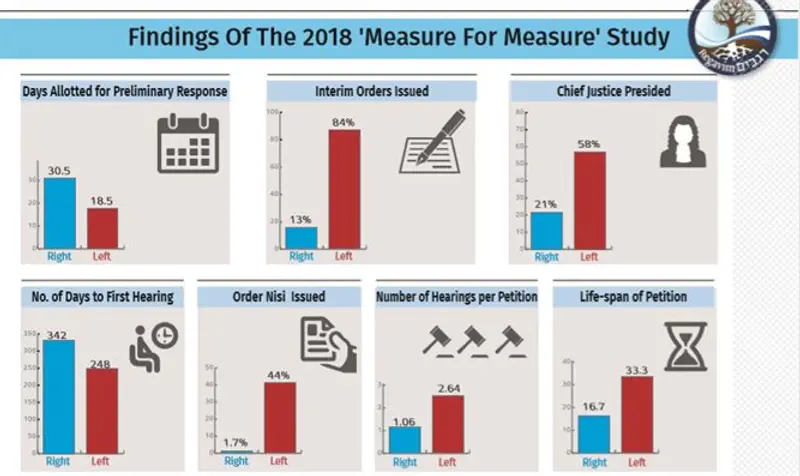
More than 100 petitions were filed in Israel's Supreme Court against illegal construction in Judea and Samaria – by organizations on both sides of the political spectrum. The Regavim legal organization analyzed the procedural aspects of all the petitions filed in the past 13 years; the findings paint a dire portrait of deep-seated, systemic bias.
The newly-released report, entitled "Measure for Measure 2018: An Index of Judicial Parity," published in the wake of the demolition of homes in the Netiv Ha'avot neighborhood of Gush Etzion, reveals the Israeli Supreme Court's endemic bias against petitions filed by organizations identified as politically right-wing or nationalist.
Regavim studied over 110 petitions filed from 2005 to 2017 by groups on both sides of the political debate. All the petitions dealt with structures that were, by all accounts, built illegally; in each case, the petitions charged the Civil Administration with failure to enforce the law. Roughly one half of the petitions were brought by leftist groups, and targeted Jewish settlements; the remainder were filed by nationalist Zionist organizations, and focused on illegal construction in the Arab sector in Judea and Samaria.
Almost without exception, the petitions filed by both sides based their arguments on identical points of law, allowing the Regavim study to focus on the procedural elements of the appeal process that impact petitions' progress and outcomes - even before substantive elements of the petition are considered in depth. The neutral, technical, "nuts and bolts" tools and procedures examined in the study reflect the underlying "starting point" or point of reference from which, and through which, judges approach a given issue.

A brief explanation of the infographic:
- In petitions filed by left-wing groups targeting Jewish construction, the State was allowed an average of only 18.5 days to file a preliminary response. In petitions filed by right-wing groups against Arab construction, the State was given 30.5 days on average to respond – creating a disadvantage of 150% for right-wing petitions.
- The waiting period (from the day the petition is filed until its first hearing) is three months longer for right-wing petitions.
- Although the petitions of both sides are based on similar, or even identical, legal issues, the number of interim orders or temporary injunctions granted to left-wing appellants is seven times higher (!!) than for right-wing cases.
- The Chief Justice presided in only 21% of right-wing cases, as opposed to 58% of left-wing cases – reflecting the Court's predisposition to consider left-wing wing cases more important or more urgent than right-wing cases – regardless of their content or legal merit.
- Of the 26 right-wing petitions in which an order nisi was requested, the Supreme Court acquiesced in only one case (1.7%), but out of 43 left-wing petitions in which an order nisi was requested, the Court acquiesced in 19 cases (44%).
- Because of the Supreme Court's massive caseload, the parameters that measure the timeframe for petitions may be the best indication of the importance ascribed to them by the Court: Petitions submitted by the left are allotted more than double the number of hearings allotted to petitions submitted by the right.
- As a result, petitions submitted by the left remain active on the Supreme Court's calendar for an average of 33.3 months, while the "lifespan" of petitions submitted by the right is only 16.7 months.
The period of time studied by the "Measure for Measure 2018" report coincides almost precisely with the tenures of three Chief Justices – Dorit Beinish, Asher Grunis, and Miriam Naor, and the report analyzes the trends and differences among their respective terms of office.
"Measure for Measure 2018: The Index of Judicial Parity" is the third in a series of cumulative reports, building on the data and analyses published in 2010 and 2015. In the wake of the first report's publication, the Supreme Court's chief administrator publicly rejected Regavim's findings, but since that time there have been improvements in a number of the parameters. Although the changes have been so slight as to be virtually imperceptible, they are hardly coincidental.
"The study's findings are a wake-up call for the judicial system," said Regavim's spokesperson. "Without the need for bombastic statements, the data speak volumes about the Supreme Court's unspoken agenda and raise serious questions about the Court's impartiality. The pattern of bias revealed in the report causes inestimable damage to the rule of law and to the centrality of the judiciary, and of the Supreme Court in particular, in our society and our democratic system."
The spokesperson added: "The 'Measure for Measure' study's findings are a warning sign, a call for introspection and recalibration in the hallowed halls of Israel's justice system that will restore the public's confidence and repair the Court's image as an impartial bastion of the rule of law."
The full report may be viewed here.